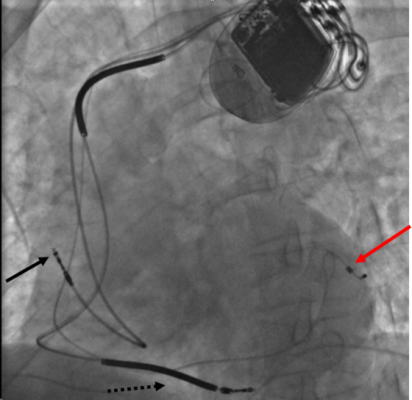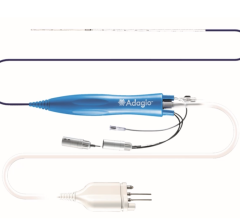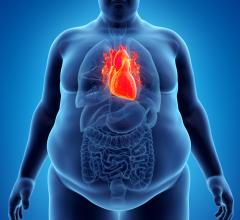
August 28, 2023 — Upgrade to cardiac resynchronization therapy with a defibrillator (CRT-D) reduces morbidity and mortality and improves left ventricular (LV) reverse remodeling compared to an implantable cardioverter-defibrillator (ICD) in select patients with heart failure and reduced ejection fraction (HFrEF) and intermittent or permanent right ventricular (RV) pacing, according to late breaking research presented in a Hot Line session today at ESC Congress 2023.1
Approximately one million conventional pacemakers or ICDs are implanted each year worldwide.2,3 Nearly 30% of these patients experience LV systolic dysfunction due to intraventricular dyssynchrony induced by RV pacing, leading to a relatively high incidence of heart failure hospitalization and associated adverse clinical outcomes.4-6 In HFrEF patients with a pacemaker or ICD, the potential benefits of an upgrade to CRT, where an extra LV lead is implanted to the coronary sinus side branch, have not been established. Due to the lack of high-quality data from large randomized controlled trials, the class/level of recommendation for CRT upgrade have been modified several times over the past decade in ESC and US guidelines,7-11 showing an unmet need for more robust evidence.
BUDAPEST CRT Upgrade was the first trial to compare the efficacy and safety of a CRT upgrade, compared to ICD alone, in HFrEF patients with a pacemaker or ICD and intermittent or permanent RV pacing. The trial enrolled heart failure patients with reduced ejection fraction (≤35%) who had received a pacemaker or ICD at least six months previously, had heart failure symptoms (New York Heart Association class II–Iva), a wide paced QRS complex (≥150 ms), a high burden of RV pacing (≥20%), and were treated with guideline-directed medical therapy. Patients were excluded if they were eligible for CRT according to current guidelines,10 had severe RV dilation, had severe valvular heart disease, had severe renal impairment or had survived an acute myocardial infarction or coronary revascularization in the previous three months.
Participants were randomly assigned to receive a CRT-D upgrade or ICD in a 3:2 ratio. For patients with an ICD at baseline who were assigned to the ICD arm, there were two options at the physician's discretion: 1) no procedure; or 2) CRT-D upgrade with the CRT function turned off. The primary outcome was the composite of heart failure hospitalization, all-cause mortality, or <15% reduction of LV end-systolic volume. Secondary outcomes included a composite of heart failure hospitalization and all-cause mortality, and echocardiographic response. Safety outcomes were also assessed. Analyses were conducted according to the intention-to-treat principle.
A total of 360 patients were enrolled from 17 sites in seven countries and randomly assigned to receive a CRT-D (n=215) or an ICD (n=145). The mean age was 72.8 years and 11.1% were women. During a median of 12.4 months, the primary outcome occurred in 58/179 (32.4%) patients in the CRT-D arm and 101/128 (78.9%) in the ICD arm (adjusted odds ratio [OR] 0.11; 95% confidence interval [CI], 0.06 to 0.19; p<0.001).12 The beneficial effect of a CRT-D upgrade was consistent across all prespecified subgroups.
Regarding secondary endpoints, the composite of heart failure hospitalization and all-cause mortality favored CRT-D compared to ICD, with an adjusted hazard ratio (HR) of 0.28 (95% CI, 0.17-0.46; p<0.001]. LV morphological and functional response according to echocardiography also favored CRT-D compared to ICD, with a difference at 12 months in LV end-diastolic volume of -39.00 mL (95% CI, -51.73 to -26.27; p<0.001) and a difference at 12 months in LV ejection fraction of 9.76% (95% CI, 7.55 to 11.98; p<0.001).
The rate of serious adverse events was about the half in the CRT-D arm compared with the ICD arm: CRT-D group 65/215 (30.2%) vs. ICD group 87/145 (60.0%). The incidence of procedure- or device-related complications was similar between the two arms: CRT-D group 25/211 (12.3%) vs. ICD group 11/142 (7.8%). The occurrence of major ventricular arrhythmias was substantially lower in the CRT-D arm (1/215 patients [0.5%]) compared to the ICD arm (21/145 patients [14.5%]).
Principal investigator Professor Béla Merkely of Semmelweis University, Budapest, Hungary said: “The findings support performing an CRT upgrade in this patient population. HFrEF patients with a pacemaker or ICD should be strictly followed in clinical practice and in those with intermittent or permanent RV pacing, a CRT upgrade should be performed immediately without deferring the procedure to a later date (e.g. battery replacement) to avoid or reduce the risk of further adverse events such as mortality, heart failure hospitalization or LV remodeling.”
For more information: www.escardio.org


 April 10, 2024
April 10, 2024 








